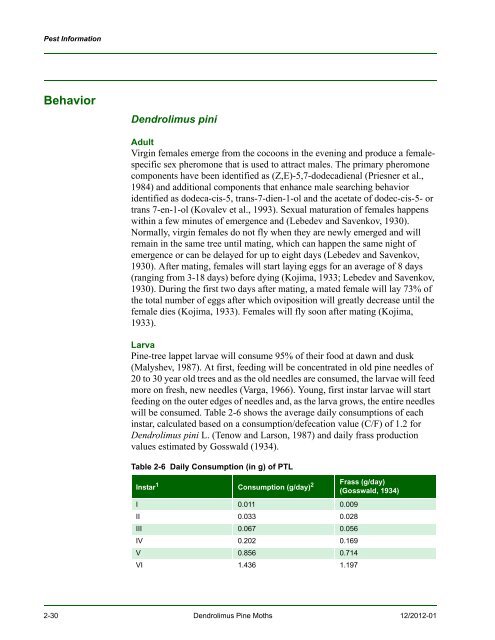New Pest Response Guidelines - aphis - US Department of Agriculture
New Pest Response Guidelines - aphis - US Department of Agriculture
New Pest Response Guidelines - aphis - US Department of Agriculture
Create successful ePaper yourself
Turn your PDF publications into a flip-book with our unique Google optimized e-Paper software.
<strong>Pest</strong> Information<br />
Behavior<br />
Dendrolimus pini<br />
Adult<br />
Virgin females emerge from the cocoons in the evening and produce a femalespecific<br />
sex pheromone that is used to attract males. The primary pheromone<br />
components have been identified as (Z,E)-5,7-dodecadienal (Priesner et al.,<br />
1984) and additional components that enhance male searching behavior<br />
identified as dodeca-cis-5, trans-7-dien-1-ol and the acetate <strong>of</strong> dodec-cis-5- or<br />
trans 7-en-1-ol (Kovalev et al., 1993). Sexual maturation <strong>of</strong> females happens<br />
within a few minutes <strong>of</strong> emergence and (Lebedev and Savenkov, 1930).<br />
Normally, virgin females do not fly when they are newly emerged and will<br />
remain in the same tree until mating, which can happen the same night <strong>of</strong><br />
emergence or can be delayed for up to eight days (Lebedev and Savenkov,<br />
1930). After mating, females will start laying eggs for an average <strong>of</strong> 8 days<br />
(ranging from 3-18 days) before dying (Kojima, 1933; Lebedev and Savenkov,<br />
1930). During the first two days after mating, a mated female will lay 73% <strong>of</strong><br />
the total number <strong>of</strong> eggs after which oviposition will greatly decrease until the<br />
female dies (Kojima, 1933). Females will fly soon after mating (Kojima,<br />
1933).<br />
Larva<br />
Pine-tree lappet larvae will consume 95% <strong>of</strong> their food at dawn and dusk<br />
(Malyshev, 1987). At first, feeding will be concentrated in old pine needles <strong>of</strong><br />
20 to 30 year old trees and as the old needles are consumed, the larvae will feed<br />
more on fresh, new needles (Varga, 1966). Young, first instar larvae will start<br />
feeding on the outer edges <strong>of</strong> needles and, as the larva grows, the entire needles<br />
will be consumed. Table 2-6 shows the average daily consumptions <strong>of</strong> each<br />
instar, calculated based on a consumption/defecation value (C/F) <strong>of</strong> 1.2 for<br />
Dendrolimus pini L. (Tenow and Larson, 1987) and daily frass production<br />
values estimated by Gosswald (1934).<br />
Table 2-6 Daily Consumption (in g) <strong>of</strong> PTL<br />
Instar 1 Consumption (g/day) 2 Frass (g/day)<br />
(Gosswald, 1934)<br />
I 0.011 0.009<br />
II 0.033 0.028<br />
III 0.067 0.056<br />
IV 0.202 0.169<br />
V 0.856 0.714<br />
VI 1.436 1.197<br />
2-30 Dendrolimus Pine Moths 12/2012-01

















